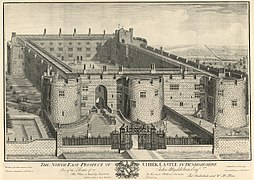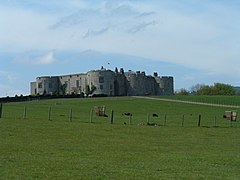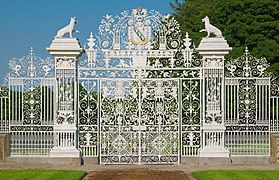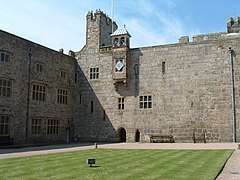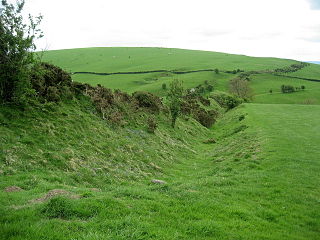
Offa's Dyke is a large linear earthwork that roughly follows the border between England and Wales. The structure is named after Offa, the Anglo-Saxon king of Mercia from AD 757 until 796, who is traditionally believed to have ordered its construction. Although its precise original purpose is debated, it delineated the border between Anglian Mercia and the Welsh kingdom of Powys.
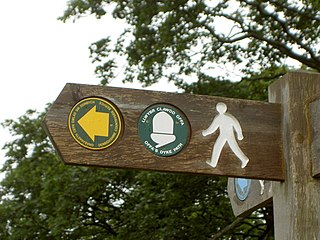
Offa's Dyke Path is a long-distance footpath loosely following the Wales–England border. Officially opened on 10 July 1971, by Lord Hunt, it is one of Britain's National Trails and draws walkers from throughout the world. About 60 miles (97 km) of the 177-mile (285 km) route either follows, or keeps close company with, the remnants of Offa's Dyke, an earthwork traditionally thought to have been constructed in the late 8th century on the orders of King Offa of Mercia.

Llansantffraed (Llansantffraed-juxta-Usk) is a parish in the community of Talybont-on-Usk in Powys, Wales, near Brecon. The benefice of Llansantffraed with Llanrhystud and Llanddeiniol falls within the Diocese of St Davids in the Church in Wales.

Chirk is a town and community in Wrexham County Borough, Wales, 10 miles south of Wrexham, between it and Oswestry. At the 2011 census, it had a population of 4,468. Historically in the traditional county of Denbighshire, and later Clwyd, it has been part of Wrexham County Borough since a local government reorganisation in 1996. The border with the English county of Shropshire is immediately south of the town, on the other side of the River Ceiriog.

Wrexham County Borough is a county borough, with city status, in the north-east of Wales. It borders the English ceremonial counties of Cheshire and Shropshire to the east and south-east respectively, Powys to the south-west, Denbighshire to the west and Flintshire to the north-west. The city of Wrexham is the administrative centre. The county borough is part of the preserved county of Clwyd.
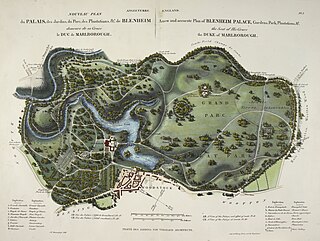
Historic garden conservation is a specialised type of historic preservation and conservation or restoration concerned with historical and landmark gardens and designed landscapes.

Erddig Hall is a Grade-I listed National Trust property near Wrexham, North Wales. Standing 2 miles (3.2 km) south of the city centre, it comprises a country house built, during the 17th and 18th centuries, amidst a 1,900-acre (770 ha) estate, which includes a 1,200-acre (490 ha) landscaped pleasure park and the earthworks of a Norman motte-and-bailey castle.

Stanage Park is a Grade II* listed Welsh country house set in a large park located some 3 miles (4.8 km) east of Knighton, Powys near the settlement of Heartsease. The extensive parkland and the house were laid out by Humphry Repton and his son, John Adey Repton, in the early nineteenth century. Repton's picturesque parkland improvements, castellated house and enclosed garden survive almost intact. The estate is the last and most complete of his three recognized Welsh landscape commissions.

Hay Castle is a medieval fortification and 17th-century mansion house in the small town of Hay-on-Wye in Powys, Wales. Originally constructed as part of the Norman invasion of Wales, the castle was designed as a ringwork overlooking the town in either the late 11th or the early 12th centuries. It was rebuilt in stone around 1200 by the de Braose family and then had a turbulent history, being attacked and burnt several times during the First and Second Barons' Wars, the wars with the Welsh princes, the rebellion of Owain Glyndŵr and the Wars of the Roses. In the 17th century a Jacobean mansion house was built alongside the medieval keep and the property became a private home. Serious fires in 1939 and 1977 gutted the castle and, despite repairs in the 1980s, by the early 21st century much of the building was derelict and unstable. Since 2011 it has been owned by Hay Castle Trust who have restored the property to form a centre for arts, literature and learning. Following the restoration, partly funded by grants from the National Lottery Heritage Fund of over £5m, the castle opened to the public on 26 May 2022.

The Clwyd-Powys Archaeological Trust is an educational charity which was established in 1975. Its objective is ‘to advance the education of the public in archaeology’. CPAT is one of four Welsh Archaeological Trusts (WATs) which work to help protect, record and interpret all aspects of the historic environment. This includes providing advice to local authorities on archaeology and planning, undertaking archaeological projects for private- and public-sector clients, and delivering a programme of community archaeology events and activities.
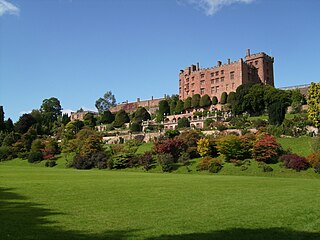
The Cadw/ICOMOS Register of Parks and Gardens of Special Historic Interest in Wales is a heritage register of significant historic parks and gardens in Wales. It is maintained by Cadw, the historic environment service of the Welsh Government and was given statutory status in 2022.

In the United Kingdom, the term listed building refers to a building or other structure officially designated as being of special architectural, historical, or cultural significance; Grade II* structures are those considered to be "particularly important buildings of more than special interest". Listing was begun by a provision in the Town and Country Planning Act 1947. Once listed, strict limitations are imposed on the modifications allowed to a building's structure or fittings. In Wales, the authority for listing under the Planning Act 1990 rests with Cadw.

Iscoyd Park is a three-storey redbrick country house in Wrexham County Borough, Wales. It has a slate roof built in the early 18th century. It was sold in 1737 to William Hanmer. The house and estate was then purchased by Philip Lake Godsal in 1843 and remains in the Godsal family to this day. Iscoyd was designated a Grade II* listed building in 1962 as a well-preserved country house. It supported by a range of 18th- and 19th-century service buildings including a park and gardens, outbuildings, coach house, corn house, kennels, laundry, piggery and stables. The dovecote has a pyramidal slate roof. The house is now run by Philip Langley Godsal and his wife Susie, who took over the house from his father Philip Caulfeild Godsal in 2009 and began a complete refurbishment. This was funded by operating as a wedding and events business but also remains the Godsal family home. Iscoyd Park has won various awards for the restoration of the house and outbuildings, including the Historic Houses Association and Sotheby's Restoration Award, the Hudson's Heritage Award for Best Wedding Venue, Hudson's Heritage Award for Best Accommodation, Wales Gold Award for Best Services Accommodation, Bridebook's Best National Wedding venue.

The archaeology of Wales is the study of human occupation within the country of Wales which has been occupied by modern humans since 225,000 BCE, with continuous occupation from 9,000 BCE. Analysis of the sites, artefacts and other archaeological data within Wales details its complex social landscape and evolution from Prehistoric times to the Industrial period. This study is undertaken by academic institutions, consultancies, charities as well as government organisations.
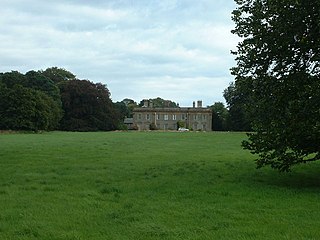
Leeswood Hall is a country house in Leeswood, Flintshire, Wales. Dating from 1742, it was built for George Wynne, the design being attributed to Francis Smith. Construction reputedly cost £40,000. The hall is a Grade II* listed building. To the northwest of the hall stand the White Gates, which have their own Grade I listing. The gates terminate the view from the hall across the lawns, an early and rare example of 18th century parkland design by Stephen Switzer, and a Grade I listed landscape of national significance.
The Vale of Montgomery is an area of low land straddling the border between Shropshire, England and the former county of Montgomeryshire, Wales. The three principal settlements within it are the former county town of Montgomery and the village of Churchstoke, both in Wales, and Chirbury in England. The earthworks of Offa's Dyke run NNW-ESE through the middle of the vale and are followed by the Offa's Dyke Path. The national boundary also follows this monument for 3 km within the vale. The River Camlad rises to the southeast of the vale whilst its tributary the Caebitra rises to its southwest. They combine at Churchstoke and flow north within a gorge along the eastern margin of the vale, before turning west across the north end of the vale to join the River Severn.

Gwaenynog is a small estate about 1 km (0.62 mi) to the south-west of the town of Denbigh, Wales. Its origins are mediaeval when it was built as a house for the Myddelton family. The Myddeltons claimed descent from Rhirid Flaidd, of the House of Cunedda, hereditary Kings of Gwynedd. Anglicising themselves and their name after the conquest of Wales, they thrived as prominent local landowners and politicians. Basing themselves ultimately at Chirk Castle, they served as receivers of Denbigh, governors of its castle and as members of parliament for Denbighshire and Denbigh Boroughs.


